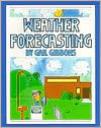Weather Forecasting by Gail Gibbons is a story that outlines the different weather patterns for each season as well as highlights the different jobs and tools involved in weather forecasting. At the beginning of each season, Gibbons displays a variety of vocabulary words that relate to the type of weather that is typical for the season. The illustrations also portray various tools that are used inside the National Weather Service and there are detailed labels as to the functions of each of these tools. Gibbons also draws the reader’s attention to different types of clouds, specific storms such as hurricanes and tornados, and professionals who rely on the weather forecast everyday.
Excerpts:
-
“The humidity is figured by reading the dew point and temperature to find the amount of moisture in the air.” (pg. 4)
-
“There are thousands of weather stations and each one reports to the nearest central office. When the immediate weather forecaster has all the hourly statistics, he sends them by computer to his central office.” (pg. 6)
-
“Outside the weather station the hourly readins are taken. Visibility is clear and the clouds are white and puffy in the sky. They are cumulus, or fair- weather, clouds.” (pg. 12)
Curriculum Connections:
Weather Forecasting is a story in which children can relate their own knowledge of weather conditions to what is written in the book. Some of the information children may know, while other information such as the work produced at the National Weather Service and the broadcasting aspect of the weather, they may not know about. This allows the students to begin thinking about the behind- the- scenes work of the weatherman they see on television. The story covers the Virignia Science SOL 2.6 in which students investigate and understand basic types, changes, and patterns of weather as well as the uses and importance of measuring and recording weather data. Weather Forecasting also touches on the Virginia Science SOL 4.6 in which students investigate how weather conditions and phenomena occur and can be predicted using meteorological tools.
Additional Resources:
-
This CanTeach lesson plan sets aside time during the day for students to observe and draw different types of clouds they see outside and label the types of clouds they see.
-
This lesson plan allows students to focus on how humans depend on their natural environment and how weather affects their every day life. Students also use the concept of listing pro’s and con’s about living in a place different from their own with changing weather patterns.
-
Discovery Education helps familiarize students with story weather, lightning, and the electrical charges inside a cloud. Students will use simple objects to form these charges and observe what happens to objects surrounding the charge.
General Information:
Book: Weather Forecasting
Author: Gail Gibbons
Illustrator: Gail Gibbons
Publisher: Simon and Schuster Children’s Publishing
Publication Date: March 1993
Pages: 32
Grade Range: 2nd- 4th
ISBN: 9780689716836

